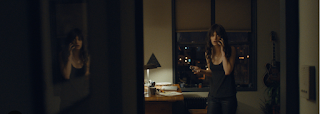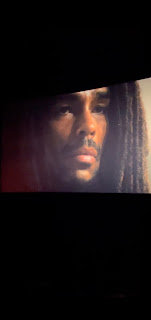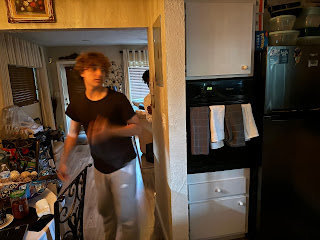Short film Research: (A Film by Vera Vaughn) (6)
Only diegetic sound in the beginning, the main character walking, opening the door, the jangling of her apartment keys, the noises coming from her laptop, her sitting down, her placing certain objects down on the table for example, her smoking her cig, her phone ringing and the voicemail that follows, and the cars driving and honking on the street outside (which indicates that that the character lives in a big city). Non-diegetic music that gives hints of rising tension begins in the scene when the character sees a shadow behind her via the camera on her laptop. However, it experiences an abrupt end when the main character goes to open the door to confront the person who's knocking loudly on her door, to find no one there. We see some asynchronous diegetic sounds further into the film such as constant knocking on the door, while the main character is within camera view. Both the characters sport different costumes and looks. The 1st character she's seen with more urban street type clothing. Wearing a jacket, top underneath it, pants, and regular sneakers. The 2nd character, however, can be seen with a more professional look with a button-up shirt underneath a good quality jacket, and what appears to be chino pants. The lighting of the 1st character's apartment appears to be dark, with the only lighting coming from either her lamp and her kitchen. Let's not disregard the fact that it's night. The 2nd character's apartment has more lighting though again it's dark due to it being night. Outside of their apartments the lighting in the corridor blinks on and off, showing that their apartment complex's lighting situation has been neglected. The corridor lights that flicker on and off add to the element of eeriness and suspense, that along with suspenseful music are few of the elements that when brewed together can produce a terrifying scare or a completely unexpected plot twist. Both of the characters do not move in an uncommon fashion. Both carry on about their tasks in an orderly manner, such as them typing and editing an apparent film on their laptops. However, their movements become much more alert when they sense that there's trouble. More so, their movements become more precise, they take slower steps, and the 1st character in particular stops the music playing from her laptop so that she can tune in and possibly identify any danger or threats that are lurking in her apartment. A few tracking shots are used, such as when the 1st main character walks into her apartment and proceeds to sit down on her desk chair. Most of the shots used are medium shots and medium close-ups before and after the climax scenes. A couple of close-ups and extreme close-ups are used, for instance, when both characters are typing on their laptops or when they each approach the door stealthily with some hesitation and caution in an attempt to figure out who exactly is knocking on their doors. Also a few long shots are used, which though long shots are unorthodox in producing tension in thrillers, that is exactly what it does in the scene when the 2nd main character walks downstairs in attempt to find the person who knocked on her door.Example of thriller films are Silence of the Lambs, Get Out, Jaws, and Fight Club. Thrillers are masters of tugging at our emotions, pulling us into their world and leaving us breathless. They do this with surgical precision, using a toolbox of techniques that tap into our primal instincts. Picture this: a jump scare erupts from the screen, triggering a surge of adrenaline and a racing heart. That's our fight-or-flight response kicking in, amplifying our engagement in the story. Then, there's the villain, a seemingly unstoppable force throwing obstacles at the protagonist. We're drawn into their desperate struggle, constantly on the edge of our seats, anticipating the next blow and wondering if the hero will prevail. Every twist and turn is a rollercoaster of tension, fear, and nail-biting anticipation. That's the magic of thrillers – they expertly weave these emotions together, creating a captivating experience that leaves us wanting more, even if it leaves our nerves a little frayed. While heart-pounding climaxes and gasp-inducing twists make my pulse race, they can leave me strangely empty afterwards. Thrillers are like buttery, salty popcorn – satisfying in the moment, but leaving me yearning for something more. It's the predictability that stings, the recycled tropes that echo like faded movie posters. Even characters, those sparks of connection forged in tense moments, often get brushed aside, sacrificed to the whirlwind pace or vanishing like mirages. I want to see them grow, not become plot points or red herrings. Thrillers, for all their adrenaline rush, sometimes feel like a dizzying carousel ride – exhilarating but ultimately hollow.



Comments
Post a Comment